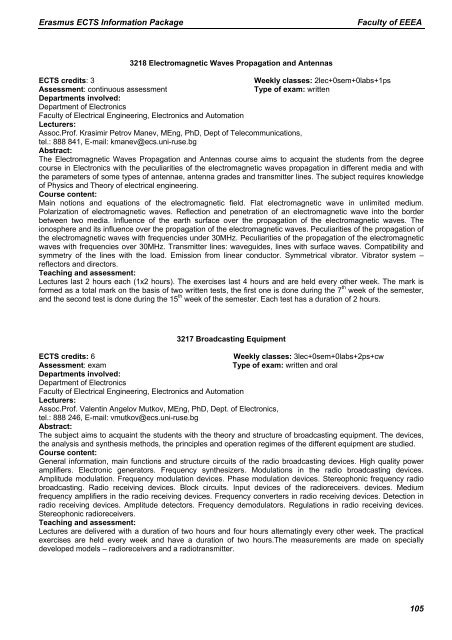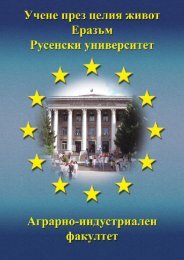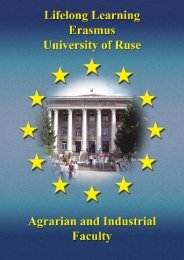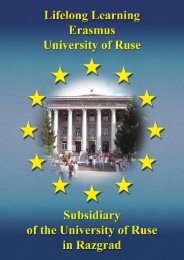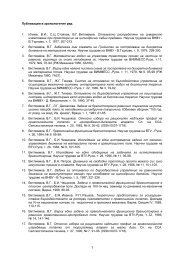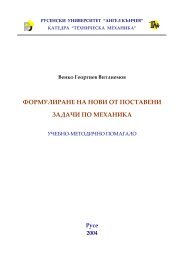Erasmus ECTS Information Package
Erasmus ECTS Information Package
Erasmus ECTS Information Package
Create successful ePaper yourself
Turn your PDF publications into a flip-book with our unique Google optimized e-Paper software.
<strong>Erasmus</strong> <strong>ECTS</strong> <strong>Information</strong> <strong>Package</strong><br />
Faculty of EEEA<br />
3218 Electromagnetic Waves Propagation and Antennas<br />
<strong>ECTS</strong> credits: 3<br />
Weekly classes: 2lec+0sem+0labs+1ps<br />
Assessment: continuous assessment<br />
Type of exam: written<br />
Departments involved:<br />
Department of Electronics<br />
Faculty of Electrical Engineering, Electronics and Automation<br />
Lecturers:<br />
Assoc.Prof. Krasimir Petrov Manev, MEng, PhD, Dept of Telecommunications,<br />
tel.: 888 841, Е-mail: kmanev@ecs.uni-ruse.bg<br />
Abstract:<br />
The Electromagnetic Waves Propagation and Antennas course aims to acquaint the students from the degree<br />
course in Electronics with the peculiarities of the electromagnetic waves propagation in different media and with<br />
the parameters of some types of antennae, antenna grades and transmitter lines. The subject requires knowledge<br />
of Physics and Theory of electrical engineering.<br />
Course content:<br />
Main notions and equations of the electromagnetic field. Flat electromagnetic wave in unlimited medium.<br />
Polarization of electromagnetic waves. Reflection and penetration of an electromagnetic wave into the border<br />
between two media. Influence of the earth surface over the propagation of the electromagnetic waves. The<br />
ionosphere and its influence over the propagation of the electromagnetic waves. Peculiarities of the propagation of<br />
the electromagnetic waves with frequencies under 30MHz. Peculiarities of the propagation of the electromagnetic<br />
waves with frequencies over 30MHz. Transmitter lines: waveguides, lines with surface waves. Compatibility and<br />
symmetry of the lines with the load. Emission from linear conductor. Symmetrical vibrator. Vibrator system –<br />
reflectors and directors.<br />
Teaching and assessment:<br />
Lectures last 2 hours each (1x2 hours). The exercises last 4 hours and are held every other week. The mark is<br />
formed as a total mark on the basis of two written tests, the first one is done during the 7 th week of the semester,<br />
and the second test is done during the 15 th week of the semester. Each test has a duration of 2 hours.<br />
3217 Broadcasting Equipment<br />
<strong>ECTS</strong> credits: 6<br />
Weekly classes: 3lec+0sem+0labs+2ps+cw<br />
Assessment: exam<br />
Type of exam: written and oral<br />
Departments involved:<br />
Department of Electronics<br />
Faculty of Electrical Engineering, Electronics and Automation<br />
Lecturers:<br />
Assoc.Prof. Valentin Angelov Mutkov, MEng, PhD, Dept. of Electronics,<br />
tel.: 888 246, Е-mail: vmutkov@ecs.uni-ruse.bg<br />
Abstract:<br />
The subject aims to acquaint the students with the theory and structure of broadcasting equipment. The devices,<br />
the analysis and synthesis methods, the principles and operation regimes of the different equipment are studied.<br />
Course content:<br />
General information, main functions and structure circuits of the radio broadcasting devices. High quality power<br />
amplifiers. Electronic generators. Frequency synthesizers. Modulations in the radio broadcasting devices.<br />
Amplitude modulation. Frequency modulation devices. Phase modulation devices. Stereophonic frequency radio<br />
broadcasting. Radio receiving devices. Block circuits. Input devices of the radioreceivers. devices. Medium<br />
frequency amplifiers in the radio receiving devices. Frequency converters in radio receiving devices. Detection in<br />
radio receiving devices. Amplitude detectors. Frequency demodulators. Regulations in radio receiving devices.<br />
Stereophonic radioreceivers.<br />
Teaching and assessment:<br />
Lectures are delivered with a duration of two hours and four hours alternatingly every other week. The practical<br />
exercises are held every week and have a duration of two hours.The measurements are made on specially<br />
developed models – radioreceivers and a radiotransmitter.<br />
105


